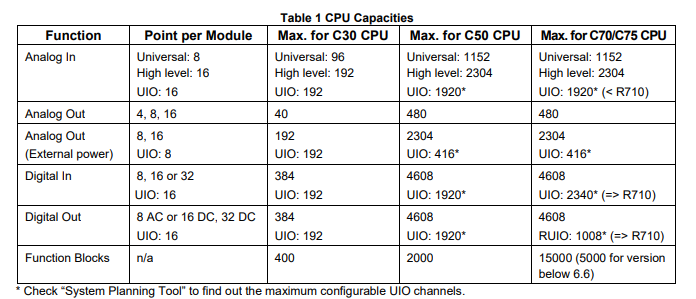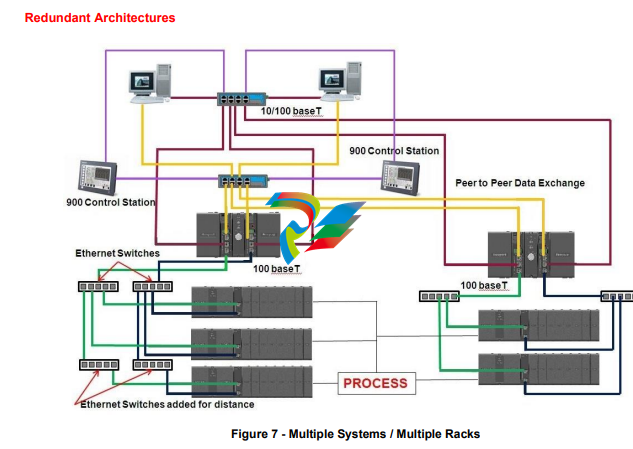
HoneywellControlEdge HC900 Controller Specifications 51-52-03-31, January 2022
Redundant Power - A second (backup) power module may
be added to each ControlEdge HC900 controller rack. An
extended rack is available that expands the standard 8 and
12 I/O rack to accommodate a second (redundant) power
supply and power status module.


Redundant Architectures
Redundant Controller
Two redundant C75 CPUs operate in a separately
mounted controller rack, each with an independent
900PS1 model power supply. A Redundant Switch
Module (RSM) is located in the rack between the two
C75 CPUs. A key switch on the RSM allows the user
to change the operating mode of the Lead CPU. There
is no I/O in the controller rack; the CPUs communicate
with up to 12 racks of I/O over a 100 base-T Ethernet
physical communication link or fiber optics with an
external media converter for greater distance. When
more than one I/O rack is used in the system, Ethernet
switches are required, one port for each Scanner
connection. In operation, all control functions and host
communication exchanges are handled by the Lead
controller, including configuration and operator
changes. The Lead controller updates the Reserve
controller every scan cycle with all the information
needed to assume control in the event of a fault
condition.
After power-up of the C75 CPUs, the first available
CPU assumes the Lead function. The Lead may be
transferred to the Reserve controller by:
• Failure of the Lead controller,
• Manually changing a keyed switch located on
the Redundant Switch Module,
• Input pin on Redundancy Status function block, or
• Instruction from host communication.
Dual Networks for Host communications are provided on the
C75 CPU. Both network ports are continuously active on the
Lead controller. Matrikon OPC server is available from
Honeywell Matrikon to support dual Ethernet
communications and automatically transfer communications.
The C75 network ports may otherwise be used in nonredundant mode where only one of the communication ports
is used.
Remote I/O - To extend the distance between the CPU rack
and the most distant I/O rack to 300m (984 ft.) up to two
Ethernet switches may be used in each I/O connection.
Distances up to 40km are possible with fiber optic cable.
Operator Interface – The 900 Control Station Operator
Interfaces (900CR series) is supported with the C75 CPU.
An Ethernet connection is made to a switch connected to
the Ethernet port of each CPU. The operator interface
communication to the controller follows the Lead controller
assignment.
Status/Diagnostics - An output parameter of the system
monitor function block of C75 CPUs provides a digital status
of the Reserve controller to allow integration of this
information into the control strategy. C75 CPUs also provide
diagnostic status on redundancy operation that may be
observed using Designer configuration software. A
Redundancy status function block is also available to
monitor redundant controller operation.
Function Blocks
A large assortment of analog and digital function
blocks are available to solve the most demanding
control requirements. Function blocks are grouped by
scan rate, fast or normal, and by function, Principal or
Standard.
Function Block Execution - All function blocks
operate synchronously with I/O processing. Inputs are
measured at the start of every scan and outputs are
updated at the end of every scan. Function blocks
such as Time Proportioning Outputs (TPO) and
Position Proportioning outputs (PPO) require higher
output resolution and are updated when the function
blocks are executing. Micro-controllers on digital I/O
modules can maintain TPO duty cycle operation during
failsafe conditions. Micro-controllers on all I/O modules
allow outputs to be configured to assume a default
state in the event of a fault condition.
Normal Scan: Function blocks that execute during the
Normal Scan are synchronized to the analog input
measurements. The fastest update rate is 500ms.
100ms analog capable from version v6.300 and above.
Note: Low Level AI updates @ 0.5 sec.
Fast Scan: The fastest update rate for fast scan
function blocks in a single controller rack is 10ms. The
update rate starts at 25ms when remote racks are
used and for redundant systems.
Principal Function Blocks – These function blocks
are supported by dedicated Widget objects in Station
Designer software for configuring 900 Control Station
operator interfaces. They have Tag names and other
attributes to support on-line user interaction. Principal
function blocks can be used any number of times in a
configuration.
Typical Principal function blocks include PID, Set Point
Programming, Sequencers, Alternators, Stage, etc
Standard Function Blocks – The number of standard
function blocks that may be used in a configuration is
virtually unlimited. Typical Standard blocks include




























































































































